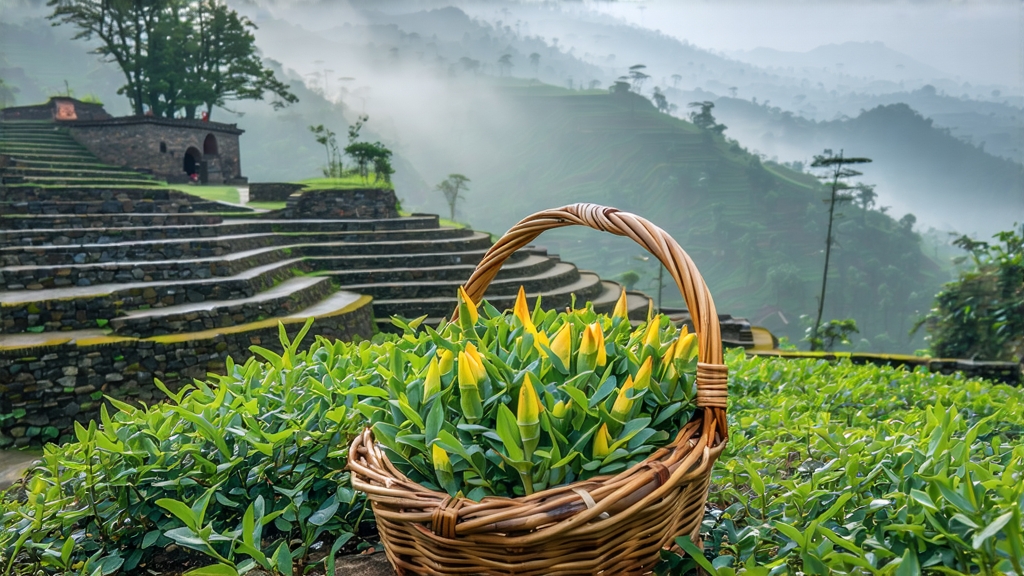
Tucked away in the high clouds of Sichuan’s Mengding Mountain, 1,450 m above the Chengdu plain, grows a tea so discreet that even seasoned drinkers often mistake it for a green tea that lost its way. Mengding Huangya—“Yellow Bud from Mengding”—is one of China’s oldest recorded teas, yet it remains the least exported of the six major families. Its story begins in the Western Han Dynasty (53 BCE) when the Daoist recluse Wu Lizhen planted seven tea bushes on the summit, declaring them “celestial herbs.” By the Tang Dynasty (618-907) the buds were carted 1,400 km north to Chang’an as imperial tribute; Song chronicles list it among “the fifteen sacred herbs of the realm.” When Ming tea masters invented the “sealed yellowing” technique in the 16th century, Mengding leaves became the archetype of China’s newest class: huangcha, yellow tea.
What separates Mengding Huangya from green tea is not a different leaf, but an extra, whisper-quiet step called menhuang—“sealed yellowing.” After the pluck—always one bud and its first unfolding leaf, 15–20 mm long—farmers kill the green enzymes in a wok barely hotter than a hand can bear (80 °C). The twist comes next: the still-warm leaves are wrapped in thin linen bundles and tucked into bamboo crates lined with yellow paper. For three nights the crates rest in a mist-cooled cave where humidity hovers at 85 %. Inside the bundle the leaf continues to breathe; chlorophyll gently oxidizes, polyphenols polymerize, and a veil of downy hairs turns from silvery jade to pale champagne. The process is repeated—wrapped, unwrapped, re-wrapped—until the leaf smells of fresh corn silk and mountain orchid. A final low-temperature bake fixes the color: a hue Chinese poets liken to “the first moon of autumn seen through silk.”
The result is a tea that occupies the narrowest bandwidth of flavor in the entire camellia universe. Infused, the liquor glows like chardonnay held to candlelight. Aroma oscillates between snap pea and baked custard, with a trace of Sichuan pepper that tingles the tip of the tongue. The taste is green tea’s clarity minus its grassy edge, plus white tea’s sweetness without its languid body. Most striking is the texture: a weightless creaminess that lingers in the throat, a sensation the locals call “mountain milk.”
To unlock this spectrum, water must be as soft as the mountain mist itself. I recommend spring water at 75 °C—any hotter and the buds blush bitter; any cooler and they remain coyly closed. Use a tall glass or a gaiwan of 120 ml; three grams (roughly a level tablespoon) is enough. Awaken the leaves with a 30-second rinse, discard, then steep for 45 seconds. The first infusion should be pale enough to read the bottom of the cup; sip while holding the cup at eye level to admire the hair-thin buds dancing upright like miniature kelp. Subsequent infusions lengthen by 15-second increments; the fifth brew often surprises with a honeyed note absent in the earlier cups. Unlike green tea, Mengding Huangya does not fade quickly—seven gentle infusions are common, each a slightly different shade of dawn.
Professional cupping follows a quieter rhythm. At the Mengding Mountain Research Station we use white porcelain bowls of 150 ml, 3 g leaf, 5 minutes, 80 °C. The wet leaf is laid on a black ceramic plate and inspected under 5500 K daylight. A perfect Huangya shows 70 % single buds, 30 % one-bud-one-leaf, every edge intact, no red bruise. The liquor is measured for clarity (turbidity < 5 NTU) and color (L 82–84, b 28–30 on the CIE scale). Aroma descriptors are recorded in triplicate: top note (fresh pea), mid note (steamed edamame), base note (sweet alfalfa). The most elusive metric is “returning milk,” a retronasal creaminess scored 0–5; top lots score ≥ 4.2.
Storage is the final secret. Because the yellowing process is technically incomplete, the leaf continues to mature. Vacuum-sealed, oxygen-free